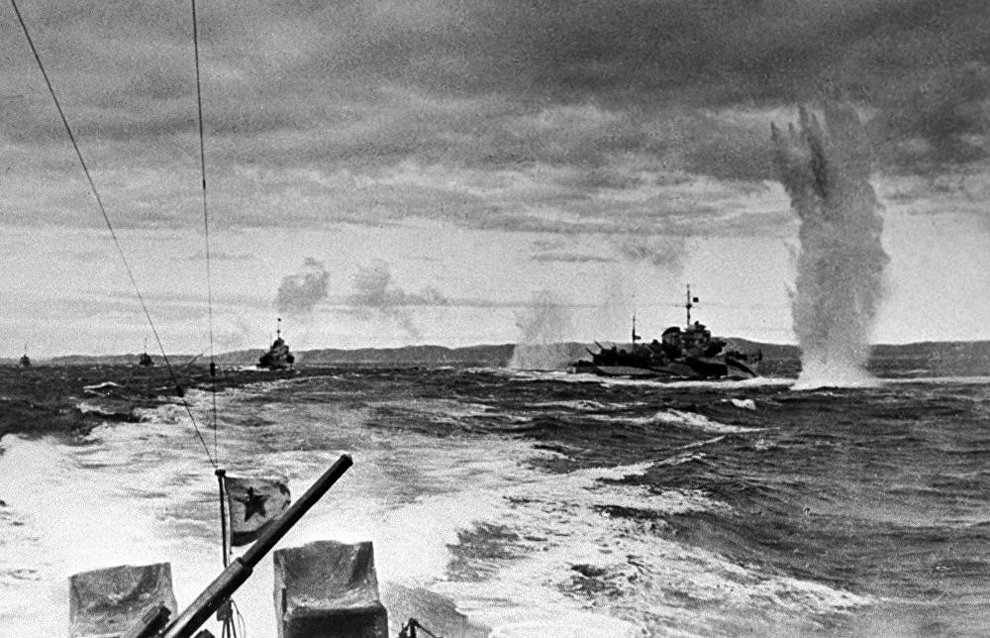2016 brings the 75th anniversary of the Dervish Convoy’s arrival in Arkhangelsk
August 2016 marks the 75th anniversary of the arrival in Arkhangelsk of the first Dervish Convoy that supplied material aid to the Soviet Union from the Western allies during the Second World War.
Two weeks after Germany invaded the Soviet Union, British Prime Minister Winston Churchill said he would do everything it takes to help the Soviet Union. It didn't take long before the first allied convoy left Liverpool on August 12, 1941 with six merchant ships, five of them cargo vessels and the sixth an auxiliary tanker. On August 31, 1941, Dervish arrived safely in Arkhangelsk. Great Patriotic War veteran Yury Budiyev recalls that all ships that came into port that day were painted in iron grey.
"Every vessel had a small dirigible balloon floating above on a steel cable to fend off enemy airplanes," he said.
Yury Budiyev on the arrival of the Dervish Convoy in Arkhangelsk
Transport vessels that arrived in Arkhangelsk delivered to the USSR strategic supplies that were crucial for the Soviet army, including 3,800 depth bombs and magnetic mines, as well as 15 Hurricane fighter planes along with equipment and ammunition for Soviet soldiers.
The Dervish Convoy was sent to the USSR under a credit clearing arrangement, which served as a precursor for the USSR's cooperation with Great Britain and later with the US. Further shipments took place under the lend-lease program.
For reference: The Lend-Lease Act, passed in 1941, created a US program to supply allies in the Second World War with ammunition, equipment, food, medical equipment and supplies and strategic commodities.
Apart from their stated goal to assist the Soviet Union with equipment and food supplies, the Arctic convoys also pursued a covert objective. In fact, the first operations in the Arctic were all more or less aimed at setting up a second front not far from Hitler's forces.
"The Arctic Convoys played an extremely important role, since it is there, up north in the Arctic, that Churchill intended until 1943 to open the second front so as to ‘unroll the map of Europe from the top'. These plans can be found in the documents of the British Army General Staff, as well as of the US and even Soviet command," Professor Mikhail Suprun, PhD in History, from the Northern (Arctic) Federal University said.
Historians agree that the importance of the Arctic Convoys during the Second World War had to do with the so-called peripheral strategy that was shared by all countries in the anti-Hitler coalition up until 1943.
"Operations of unprecedented scale took place there, with more than 40 countries and representatives of a dozen fleets taking part. Of course, the importance of this experience can hardly be overstated," Suprun went on to say. However, it was the Dervish Convoy that was the first and most important initiative of this kind, since it was this convoy that charted the route to Arkhangelsk.
Professor Mikhail Suprun about the Dervish Convoy
All in all, 41 sea convoys with a total of more than 800 cargo vessels carrying some 4 million tons of strategic goods made their way into the northern ports of the Soviet Union in 1941-1944, delivering, among other things, 5,000 tanks, 7,000 airplanes, thousands of cars and trucks, tens of thousands of rounds of ammunition, equipment and food supplies.
To mark the anniversary of the first Allied Arctic convoy's arrival in the USSR, Arkhangelsk and Severodvinsk will host a number of events on August 29-31, including a conference Lend Lease and the Arctic Convoys: From Regional Cooperation to a Global Coalition, the sixth international forum To the Glory of the Navy and the Fatherland!, as well as commemorative events and concerts.
Representatives from ten countries are expected to attend celebrations in Arkhangelsk, including Great Britain, the US, Canada, Iceland, the Netherlands, Sweden, New Zealand, Australia, France and Poland.
